Thermography
|
WikiDoc Resources for Thermography |
|
Articles |
|---|
|
Most recent articles on Thermography Most cited articles on Thermography |
|
Media |
|
Powerpoint slides on Thermography |
|
Evidence Based Medicine |
|
Clinical Trials |
|
Ongoing Trials on Thermography at Clinical Trials.gov Clinical Trials on Thermography at Google
|
|
Guidelines / Policies / Govt |
|
US National Guidelines Clearinghouse on Thermography
|
|
Books |
|
News |
|
Commentary |
|
Definitions |
|
Patient Resources / Community |
|
Patient resources on Thermography Discussion groups on Thermography Patient Handouts on Thermography Directions to Hospitals Treating Thermography Risk calculators and risk factors for Thermography
|
|
Healthcare Provider Resources |
|
Causes & Risk Factors for Thermography |
|
Continuing Medical Education (CME) |
|
International |
|
|
|
Business |
|
Experimental / Informatics |
Editor-In-Chief: C. Michael Gibson, M.S., M.D. [1]
Please Take Over This Page and Apply to be Editor-In-Chief for this topic: There can be one or more than one Editor-In-Chief. You may also apply to be an Associate Editor-In-Chief of one of the subtopics below. Please mail us [2] to indicate your interest in serving either as an Editor-In-Chief of the entire topic or as an Associate Editor-In-Chief for a subtopic. Please be sure to attach your CV and or biographical sketch.
Overivew
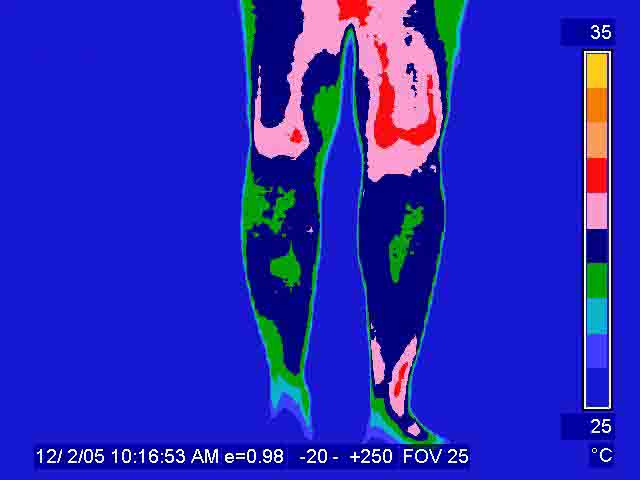
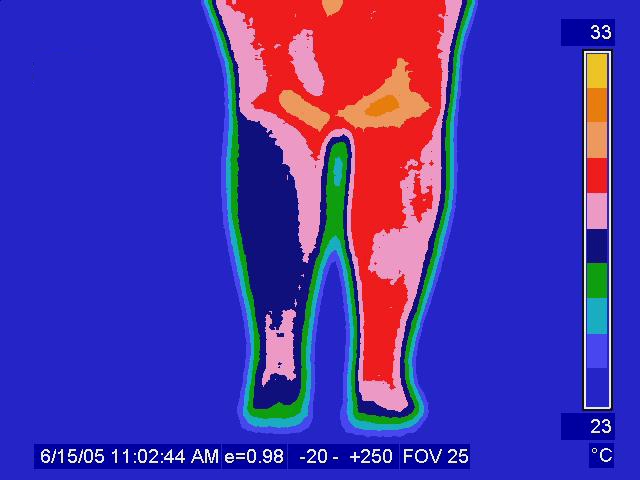

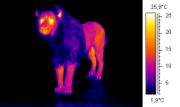
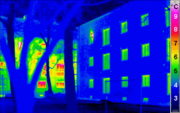
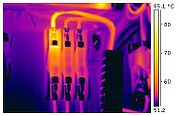
Thermography, thermal imaging, or thermal video, is a type of infrared imaging. Thermographic cameras detect radiation in the infrared range of the electromagnetic spectrum (roughly 900–14,000 nanometers or 0.9–14 µm) and produce images of that radiation. Since infrared radiation is emitted by all objects based on their temperatures, according to the black body radiation law, thermography makes it possible to "see" one's environment with or without visible illumination. The amount of radiation emitted by an object increases with temperature, therefore thermography allows one to see variations in temperature (hence the name). When viewed by thermographic camera, warm objects stand out well against cooler backgrounds; humans and other warm-blooded animals become easily visible against the environment, day or night. As a result, thermography's extensive use can historically be ascribed to the military and security services.
Thermal imaging photography finds many other uses. For example, firefighters use it to see through smoke, find persons, and localize the base of a fire. With thermal imaging, power lines maintenance technicians locate overheating joints and parts, a telltale sign of their failure, to eliminate potential hazards. Where thermal insulation becomes faulty, building construction technicians can see heat leaks to improve the efficiencies of cooling or heating air-conditioning. Thermal imaging cameras are also installed in some luxury cars to aid the driver, the first being the 2000 Cadillac DeVille. Some physiological activities, particularly responses, in human beings and other warm-blooded animals can also be monitored with thermographic imaging. [3]
The appearance and operation of a modern thermographic camera is often similar to a camcorder. Enabling the user to see in the infrared spectrum is a function so useful that ability to record their output is often optional. A recording module is therefore not always built-in.
Instead of CCD sensors, most thermal imaging cameras use CMOS Focal Plane Array (FPA). The most common types are InSb, InGaAs, QWIP FPA. The newest technologies are using low cost and uncooled microbolometers FPA sensors. Their resolution is considerably lower than of optical cameras, mostly 160x120 or 320x240 pixels, up to 640x512 for the most expensive models. Thermographic cameras are much more expensive than their visible-spectrum counterparts, and higher-end models are often export-restricted. Older bolometers or more sensitive models as InSB require cryogenic cooling, usually by a miniature Stirling cycle refrigerator or liquid nitrogen.
Difference between IR film and thermography
IR film is sensitive to temperatures between 250 °C and 500 °C while thermography is sensitive to approximately -50 °C to over 2,000 °C. So for a IR film to show something it must be over 250 °C or be reflecting infrared radiation from something that is at least that hot. Night vision goggles normally just amplify the small amount of light that is available outside like starlight or moon light and can't see heat or work in complete darkness.
Advantages of Thermography
- You get a visual picture so that you can compare temperatures over a large area
- It is real time capable of catching moving targets
- Able to find deteriorating components prior to failure
- Measurement in areas inaccessible or hazardous for other methods
Limitations & disadvantages of thermography
- Quality cameras are expensive and are easily damaged
- Images can be hard to interpret accurately even with experience
- Accurate temperature measurements are very hard to make because of emissivities
- Most cameras have ±2% or worse accuracy (not as accurate as contact)
- Training and staying proficient in IR scanning is time consuming
Applications
- Condition monitoring
- Medical imaging
- Research
- Process control
- Non destructive testing
- Chemical imaging
Thermal infrared imagers convert the energy in the infrared wavelength into a visible light video display. All objects above 0 kelvins emit thermal infrared energy so thermal imagers can passively see all objects regardless of ambient light. However, most thermal imagers only see objects warmer than -50 °C.
The spectrum and amount of thermal radiation depend strongly on an object's surface temperature. This makes it possible for a thermal camera to display an object's temperature. However, other factors also influence the radiation, which limits the accuracy of this technique. For example, the radiation depends not only on the temperature of the object, but is also a function of the emissivity of the object. Also, radiation also originates from the surroundings and is reflected in the object, and the radiation from the object and the reflected radiation will also be influenced by the absorption of the atmosphere.
See also
External links
- Good examples of FLIR thermographic images broken down by industry application
- IrInfo.org, online resource for infrared thermography
- Physical basics
- various examples of thermographic images
- Uncooled Thermal Imaging
ca:Termografia de:Thermografie it:Termografia he:תרמוגרפיה nl:Thermografie ur:حراری تخطیط Template:WH Template:WikiDoc Sources